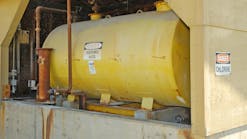DENVER, CO, Nov. 28, 2014 -- Through recently completed research and development of a new leakage analysis tool, the Water Research Foundation (WRF) is helping water utilities better understand and control leakage in a cost-effective manner. Called "Water Audits and Real Loss Component Analysis" (#4372), the project provides water utilities information to better understand the sources of their losses from leakage in the water distribution system and ultimately serves as a tool to help analyze the economic impact of various intervention strategies.
The vast majority of water utilities in North America employ reactive leakage management strategies, through which failures are repaired when they are reported to the utility. Because of this, utilities are continuing to experience increases in leakage losses throughout the distribution system due to a rising backlog of unreported distribution system failures. These losses continue to mount in spite of the fact that significant industry research has demonstrated the economic and efficiency gains that can be achieved through proactive leakage management.
In order to develop an effective and proactive leakage loss reduction strategy, utilities must undertake three major steps: a "top-down" water audit; component analysis of real losses; and evaluation of least-cost, real-loss reduction strategies. The water audit estimates revenue and non-revenue water, as well as real losses as a sub-category of non-revenue water. The leakage component analysis further determines the known real losses and categorizes them into three types of leakage: reported, unreported or background. This step includes water audit results, utility data on specific leak occurrences and a calculation of background losses.
By combining the component analysis with an evaluation of least-cost, real-loss reduction strategies, it is possible to calculate how much of each type of leakage can be economically reduced through the right combination of intervention tools. Very few water utilities have the necessary expertise in leakage loss management to efficiently undertake a leakage component analysis and design the correct leakage control program. Water Research Foundation project #4372 was designed to fill this gap.
WRF and the Environmental Protection Agency (EPA) sponsored this research project that involved 10 utilities of various sizes from throughout North America. The full report and Component Analysis Model can be accessed through the WRF Website. A recently conducted webcast on the project is also available on demand. Lastly, this project is featured in the latest edition of WRF's magazine, Advances in Water Research.
See also:
"New research reveals water utility sector's impact on U.S. economy"
"New benchmarking tool helps water plants meet effective utility management goals"
About the Water Research Foundation
The Water Research Foundation is an internationally recognized leader in sponsoring research that supports the water community in holistically and cooperatively managing water from all sources to meet social, environmental, and economic needs. WRF’s research provides reliable and relevant solutions to the most critical challenges facing the water community today and into the future. Founded in 1966, WRF is a 501(c)(3) non-profit organization that has sponsored nearly 1,500 research projects and serves more than 1,000 subscribing organizations. For more information, visit www.WaterRF.org.
###


